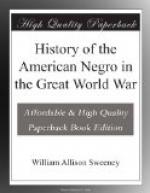At the Moselle river, Pont a Mousson and Madieres, the regiment first saw action. The first and second battalions went into action immediately in the vicinity of St. Genevieve and Alton. The third battalion crossed the river and went into action in the vicinity of Pont a Mousson. That was on October 31st. The balance of the regiment’s service corresponds to that of the brigade, already mentioned.
As already gleaned from the reports of generals, regimental officers and the testimony of the chaplain of the 351st, the artillery boys created a good impression and left behind them a clean record everywhere. It has remained for the officers of the 349th regiment to preserve this in additional documentary form in the shape of regimental orders and letters from the mayors of French towns in which the regiment stopped or was billeted. The following are some of the bulletins and letters:
Headquarters
349th Field
Artillery, American Expeditionary
Forces, France, A.P.O. 722,
September 6, 1918.
The following letter having been received, is
published
for the information of the regiment, and will be read
at retreat Saturday, September 7, 1918. By order
of
colonel Moore.
Joseph H. McNALLY, Captain and Adjutant.
French republic
Town Hall of Montmorillion
(Vienne)
Montmorillion, August 12,
1918.
Dear Colonel:
At the occasion of your departure permit me to
express
to you my regrets and those of the whole population.
From the very day of its arrival your regiment,
by its
behavior and its military appearance, it excited the
admiration of all of us.
Of the sojourn of yourself and your colored soldiers
among us we will keep the best memory and remember
your
regiment as a picked one.
From the beginning a real brotherhood was established
between your soldiers and our people, who were glad
to
welcome the gallant allies of France.
Having learned to know them, the whole population
holds them in great esteem, and we all join in saying
the
best of them.
I hope that the white troops replacing your regiment
will give us equal satisfaction; but whatever their
attitude may be, they cannot surpass your 349th Field
Artillery. Please accept the assurance of my
best and most
distinguished feelings.
G. De Font-REAULX,
Assistant Mayor.
Headquarters 349th Field
Artillery, American Expeditionary
Forces, France, A.P.O.
766,
January 25, 1919.
The following letter having been received is
published
for the information of the regiment. By order
of
colonel O’NEIL.
George B. Compton, Captain and Adjutant.
MAIRIE de Domfront
(Orne)
Domfront, January 22, 1919.
The mayor of the town of Domfront has the very
great
pleasure to state and declare that the 349th regiment




